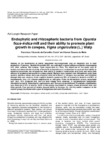Por favor, use este identificador para citar o enlazar este ítem:
http://www.alice.cnptia.embrapa.br/alice/handle/doc/942700Registro completo de metadatos
| Campo DC | Valor | Lengua/Idioma |
|---|---|---|
| dc.contributor.author | COSTA, F. E. C. | pt_BR |
| dc.contributor.author | MELO, I. S. de | pt_BR |
| dc.date.accessioned | 2012-12-14T11:11:11Z | pt_BR |
| dc.date.available | 2012-12-14T11:11:11Z | pt_BR |
| dc.date.created | 2012-12-14 | pt_BR |
| dc.date.issued | 2012 | pt_BR |
| dc.identifier.citation | African Journal of Microbiology Research, v. 6, n. 6, p. 1345-1353, 2012. | pt_BR |
| dc.identifier.uri | http://www.alice.cnptia.embrapa.br/alice/handle/doc/942700 | pt_BR |
| dc.description | ABSTRACT: Studies on the biodiversity of plants associated microorganisms play an important role in food production. Ficus-tree, Opuntia ficus-indica Mill, are cultivated in many nations worldwide intercropping with other cultures, like cowpea, Vigna unguiculata (L.) Walp. The objectives of this study were to isolate and determine the diversity of bacterial endophytes and rhizobacteria in cacti and their ability to solubilize phosphate, the nif presence, their ability to produce indole-acetic acid (IAA) and verify their efficacy to promote plant growth in cowpea plants. Bacteria were isolated from rhizospheric soils, from surface- sterilized stems and roots of plants collected in Brazil, in nitrogen- free medium, and identified through fatty acid analysis. Gram-negative bacteria comprised 63% of endophytic bacteria and 80% of rhizobacteria. Only 13% showed amplification of nifH gene. From the 68 bacterial strains, associated with cacti, 18% produced IAA, and the best results were observed in Agrobacterium radiobacter, Klebsiella trevisanii, Enterobacter agglomerans and Paracoccus denitrificans. Phosphate solubilization was observed in 6% of strains. None of the strains inoculated in cowpea plants promoted stem and foliar growth. Four percent of strains showed ability to increase the root dry matter compared to the control group (inoculated with a pool of indigenous semi-arid Rhizobium). | pt_BR |
| dc.language.iso | eng | eng |
| dc.rights | openAccess | eng |
| dc.subject | Phosphate solubilization | pt_BR |
| dc.subject | Feijão caupi | pt_BR |
| dc.subject | Ndole acetic acid | pt_BR |
| dc.title | Endophytic and rhizospheric bacteria from Opuntia ficus-indica mill and their ability to promote plant growth in cowpea, Vigna unguiculata (L.) Walp. | pt_BR |
| dc.type | Artigo de periódico | pt_BR |
| dc.date.updated | 2012-12-14T11:11:11Z | pt_BR |
| dc.subject.thesagro | Cacto | pt_BR |
| dc.subject.thesagro | Bactéria | pt_BR |
| dc.subject.thesagro | Rizosfera | pt_BR |
| dc.subject.thesagro | Regulador de crescimento | pt_BR |
| dc.subject.thesagro | Estimulante de crescimento vegetal | pt_BR |
| dc.subject.thesagro | Feijão de corda | pt_BR |
| dc.subject.thesagro | Vigna Unguiculata | pt_BR |
| dc.subject.nalthesaurus | Endophytes | pt_BR |
| dc.subject.nalthesaurus | Cacti and succulents | pt_BR |
| dc.subject.nalthesaurus | Growth promotion | pt_BR |
| dc.subject.nalthesaurus | Opuntia ficus-indica | pt_BR |
| dc.subject.nalthesaurus | rhizosphere | pt_BR |
| riaa.ainfo.id | 942700 | pt_BR |
| riaa.ainfo.lastupdate | 2012-12-14 | pt_BR |
| dc.contributor.institution | FRANCISCO EDUARDO DE CARVALHO COSTA; ITAMAR SOARES DE MELO, CNPMA. | pt_BR |
| Aparece en las colecciones: | Artigo em periódico indexado (CNPMA)  | |
Ficheros en este ítem:
| Fichero | Descripción | Tamaño | Formato | |
|---|---|---|---|---|
| 2012AP49.pdf | 105,68 kB | Adobe PDF |  Visualizar/Abrir |









